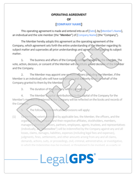Transferring LLC Membership Interests: Family-Focused Agreements for 2025
Family businesses represent the backbone of American entrepreneurship, with over 5.5 million family-owned companies generating trillions in annual...
8 min read
LegalGPS : Sep. 12, 2025
Building a business legacy that spans generations requires more than just a successful company. Smart entrepreneurs understand that protecting their life's work from taxes, creditors, and family disputes demands sophisticated planning. An LLC family trust combines the operational flexibility of a limited liability company with the protective benefits of a trust structure, creating a powerful tool for business succession and wealth preservation.


Legal GPS Pro
Protect your business with our complete legal subscription service, designed by top startup attorneys.
This comprehensive approach to business protection has gained significant traction among entrepreneurs who want to maintain control while gradually transferring ownership to the next generation. The strategy becomes particularly valuable as businesses grow and family dynamics become more complex.
An LLC family trust is a legal arrangement where a family trust owns membership interests in a limited liability company. The trust serves as the technical owner of the LLC, while family members serve as beneficiaries who ultimately receive the economic benefits of the business.
This structure creates a separation between legal ownership and beneficial ownership. The trust document governs how the LLC interests are managed and distributed, providing a framework for multi-generational business planning that goes far beyond simple will-based inheritance.
The arrangement matters because it addresses three critical challenges that destroy many family businesses. First, it provides asset protection that shields business value from individual creditors and legal judgments. Second, it creates tax advantages that can save families hundreds of thousands of dollars over time. Third, it establishes clear succession rules that prevent family disputes from tearing apart successful businesses.
Modern family trust structures offer flexibility that previous generations couldn't access. Today's entrepreneurs can maintain operational control while systematically transferring ownership, creating smooth transitions that preserve both family relationships and business value.

LLC Family Trust Agreement
Use a Family Trust to keep LLC ownership in the family. This agreement can help protect assets across generations while supporting a clear succession and tax-efficient structure.
Trusted by 1,000+ businesses to safeguard their LLCs.
Asset protection represents the most immediate benefit of this structure. When properly established, the trust creates legal barriers between business assets and individual liabilities. If a family member faces a lawsuit or creditor claims, the LLC interests held in trust remain protected from attachment.
This protection works both ways. Business liabilities typically cannot reach trust beneficiaries' personal assets, and personal liabilities cannot easily reach business assets held in the trust. The structure creates what estate planning attorneys call "charging order protection" that makes it extremely difficult for creditors to access business value.
Tax planning opportunities emerge from the ability to make gradual transfers of business interests over time. Instead of triggering massive estate taxes when the business founder dies, the trust structure allows for systematic gifting of LLC interests that utilize annual gift tax exclusions and lifetime exemptions. This approach can save families millions in transfer taxes on valuable businesses.
The succession planning advantages become apparent when multiple family members need coordinated involvement in business ownership. The trust document can specify exactly how business interests transfer between generations, eliminating ambiguity that often leads to costly family disputes.
Establish your LLC family trust while your business is still growing rather than waiting until it reaches peak value. Early creation allows you to transfer interests at lower valuations, maximizing the effectiveness of gift tax exemptions and reducing future estate tax exposure.
The trust structure operates through carefully defined relationships between different parties. The grantor (business founder) creates the trust and initially funds it, often by transferring LLC membership interests. Trustees manage the trust assets according to the trust document's terms, while beneficiaries receive distributions and ultimately inherit the business interests.
LLC ownership through the trust means the trust appears on the LLC's member records as the legal owner of specific membership interests. The trust document then determines how voting rights, management authority, and economic benefits flow to family members.
This creates important distinctions between management control and beneficial ownership. A business founder might retain management authority through the LLC's operating agreement while the trust owns the underlying economic value. This arrangement allows continued operational control while systematic wealth transfer occurs.
Distribution mechanisms can be tailored to family needs and business realities. Some trusts provide immediate income distributions to beneficiaries, while others accumulate value for future transfers. The flexibility allows families to balance current needs with long-term wealth preservation goals.
Robert Chen built his precision manufacturing company over thirty years, growing it to $15 million in annual revenue. At age 58, he established an LLC family trust and gradually transferred 60% of his business interests to the trust over five years. His three children serve as beneficiaries, with his eldest daughter managing daily operations.
The trust structure protected the business when Robert's son faced a divorce proceeding. Because the son's business interests were held in trust rather than owned directly, they remained protected from the divorce settlement. The family avoided potentially losing a third of their business to an ex-spouse.
When Robert suffered a heart attack at 63, the succession plan activated smoothly. His daughter assumed full management control while the trust continued generating income for all three children. The family avoided the chaos that typically follows sudden leadership changes in family businesses.
Prerequisites include having a properly formed LLC with a comprehensive operating agreement that anticipates trust ownership. The LLC documentation must specifically address how trust-owned interests are managed, voted, and transferred. Without proper LLC groundwork, the trust structure cannot function effectively.
Choosing the right trust type depends on your specific goals and family situation. Revocable trusts provide maximum flexibility but offer limited asset protection benefits. Irrevocable trusts provide stronger protection and tax benefits but reduce the grantor's control over trust assets. Generation-skipping trusts add another layer of tax efficiency for families with significant wealth.

Creating the trust document requires careful attention to management provisions, distribution standards, and succession rules. The document must coordinate with your LLC operating agreement to ensure smooth operation. Critical provisions include trustee selection criteria, beneficiary rights, and procedures for adding or removing beneficiaries.
Transferring LLC interests to the trust involves formal assignment documents and compliance with your operating agreement's transfer restrictions. Some transfers may trigger gift tax consequences that require careful planning and proper valuation. The transfer process typically occurs gradually over several years to maximize tax efficiency.
Maria Rodriguez owned a portfolio of rental properties through her LLC, generating substantial monthly income. After a tenant sued her personally following a slip-and-fall accident, she realized her assets needed better protection.
She established an irrevocable family trust and transferred 75% of her LLC interests to the trust, with her two adult children as beneficiaries. The trust structure protected her real estate portfolio from future personal liability claims while providing systematic wealth transfer to her children.
When Maria's tenant won a $200,000 judgment against her personally, the creditor could only reach her remaining 25% LLC interest. The trust-owned interests remained completely protected, preserving three-quarters of her real estate portfolio for her family.
Inadequate planning represents the most costly mistake in LLC family trust creation. Many entrepreneurs rush into trust structures without properly analyzing their specific needs or coordinating all legal documents. This approach often creates conflicts between trust terms and LLC operating agreements that undermine the entire structure.
Tax compliance oversights can trigger unexpected tax consequences that eliminate the trust's benefits. Common problems include failing to obtain proper business valuations for gift tax purposes, missing required trust tax filings, or incorrectly structuring distributions. These mistakes can result in significant penalties and lost tax benefits.
Control structure problems emerge when families fail to clearly define management authority and decision-making processes. Conflicts between trustees, LLC managers, and beneficiaries can paralyze business operations. Clear documentation of roles and responsibilities prevents these costly disputes.
Family communication failures often doom otherwise well-structured plans. When family members don't understand their roles or the trust's purpose, they may take actions that undermine its effectiveness. Regular family meetings and education prevent misunderstandings that can destroy years of planning.
Build flexibility into your trust structure by including provisions for changing trustees, modifying distribution terms, and adapting to new tax laws. Include "trust protector" roles that can make certain modifications without court approval, ensuring your structure can evolve with changing family and business needs.
Complexity indicators suggest professional assistance is essential rather than optional. If your business generates more than $1 million annually, involves multiple family members, or faces significant liability exposure, the trust structure requires expert design and implementation.
Professional team assembly should include an experienced estate planning attorney, tax advisor familiar with business structures, and possibly a corporate trustee for ongoing management. Each professional brings specialized knowledge that prevents costly mistakes and ensures optimal structure design.
Cost-benefit analysis typically shows that professional fees represent a small fraction of potential tax savings and asset protection benefits. The upfront investment in proper planning prevents much larger costs from tax penalties, family disputes, or inadequate protection.
David Kim founded a software company that experienced rapid growth, reaching $5 million in annual revenue within three years. Anticipating continued expansion and eventual sale, he established a grantor retained annuity trust (GRAT) structure holding his LLC interests.
The GRAT allowed David to transfer significant business appreciation to his children while retaining income during the trust term. When his company sold for $45 million five years later, the trust structure saved his family over $3 million in estate taxes compared to direct ownership.
The professional team that designed the structure cost $25,000 in initial fees but delivered tax savings worth 120 times that investment. The comprehensive planning also protected the business value from David's personal creditors during the high-growth phase.
Managing family dynamics requires proactive communication and clear expectations. Regular family meetings should address trust operations, business performance, and beneficiary concerns. Transparency prevents misunderstandings while maintaining appropriate boundaries between business management and family relationships.
Consider establishing family employment policies that govern when and how family members can join the business. These policies protect both the business and family relationships by creating objective standards for involvement. Include provisions for education requirements, outside experience, and performance evaluation.
Document all major decisions and maintain detailed records of trust operations. Proper documentation demonstrates the trust's legitimate business purposes and supports its tax and legal benefits. Poor record-keeping can undermine the entire structure during IRS audits or legal challenges.
The Morales family built a successful restaurant chain over two generations, with locations across three states. As the second generation approached retirement, they used an LLC family trust structure to transition control to the third generation while maintaining family unity.
The trust owned 80% of the restaurant LLC, with the third generation serving as beneficiaries. Clear governance policies addressed management succession, expansion decisions, and profit distributions. The structure allowed gradual leadership transition while preserving the business culture that drove success.
When two third-generation members wanted to pursue other careers, the trust structure provided mechanisms for them to receive fair value for their interests without disrupting business operations. The family avoided the conflicts that typically arise when some members want to exit the family business.
Assessment begins with analyzing your current business structure, family situation, and long-term goals. Consider factors like business value, growth trajectory, family involvement levels, and existing estate planning documents. This analysis determines whether an LLC family trust structure makes sense for your situation.
Timeline planning typically requires six to twelve months for complete implementation. The process includes business valuation, trust document preparation, LLC operating agreement revisions, and systematic transfer of interests. Starting early allows time for proper planning and tax-efficient implementation.
Legal GPS provides comprehensive resources for entrepreneurs considering family trust structures. Our business formation templates include LLC operating agreements designed to work with trust ownership. Our Pro subscription offers ongoing access to legal updates and planning resources that keep your structure current with changing laws.
Professional guidance remains essential for complex situations, but proper templates and resources can streamline the process and reduce costs. The combination of professional expertise and quality documentation tools provides the best foundation for successful implementation.
The investment in proper LLC family trust planning pays dividends across generations. Families that take proactive steps to protect and transfer their business wealth create lasting legacies that benefit children and grandchildren for decades to come.
Start your planning process today by evaluating your business and family situation. The sooner you begin, the more options you'll have for tax-efficient wealth transfer and comprehensive asset protection. Your family's financial security and your business legacy depend on the decisions you make now.

Legal GPS Pro
Protect your business with our complete legal subscription service, designed by top startup attorneys.
|
Premium Template
Single-use Template |
Legal GPS Pro
Unlimited Access, Best Value |
|
|
| Choose Template | Learn More |
| Trusted by 1000+ businesses | |

Family businesses represent the backbone of American entrepreneurship, with over 5.5 million family-owned companies generating trillions in annual...

Family businesses face a sobering statistic: only 30% survive to the second generation, and just 12% make it to the third. The primary cause isn't...

The statistics are sobering: only 30% of family businesses survive into the second generation, and just 12% make it to the third. Behind these...